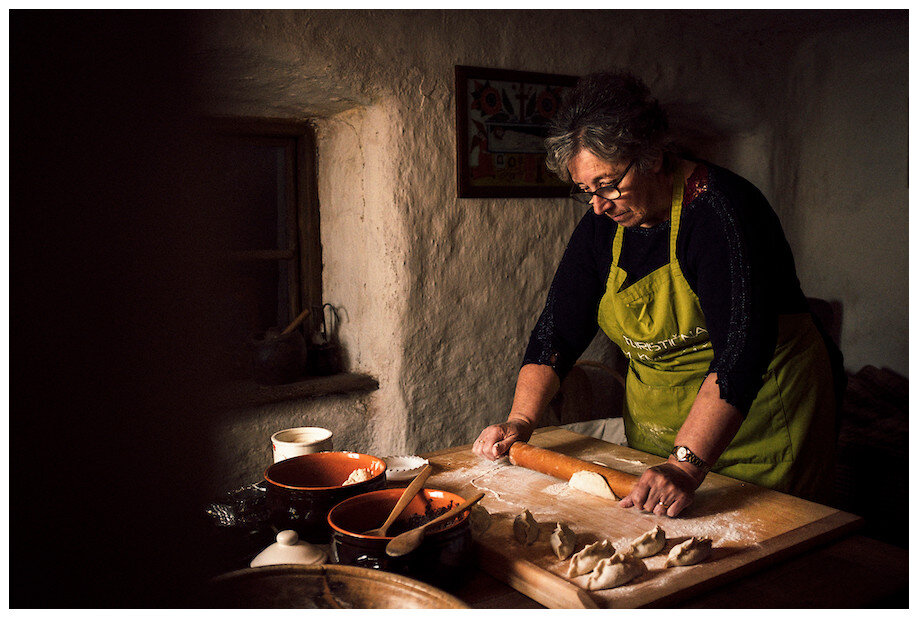What is Slovenian Food? Here are 4 Traditional Soča Valley Dishes
Kliknite tukaj za slovenski prevod vsebine bloga
A traditional Slovenian dish? There is no straight answer to this question. A tiny country squeezed between the Mediterranean, the Julian Alps, the Karst, and the Pannonian plain is a palette of distinctive flavours. Slovenia is sliced into 24 gastronomic regions that offer 365 official local dishes. One of the bigger slices belongs to Soča Valley in the northwest corner of Slovenia.
Home to magnificent peaks, deep canyons, waterfalls, and the outstanding Soča river, the valley is a real treat! If you love food and you are seeking an authentic experience, you are in the right place. From Trenta to Nova Gorica, the Soča Valley region hosts some of the best fine dining places in the country, but let’s start where it all began – in the mountains.
The valley’s rich history, remote life far from the cities, its border location and contrasting landscape have shaped local traditions, habits, and lifestyles. Back in the days, the food of the country folk was simple and modest. Locals were mainly farmers and shepherds lived closely with nature and ate whatever the land provided. The cuisine was based on dairy products from sheep, goats, and cows grazing freely in the high mountains. Most people were growing potatoes since the plant is hearty and can grow in the higher regions.
These basic ingredients inspired great ideas, authenticity, and witty competition. The villages and towns scattered throughout the Soča Valley each have their local recipe, each family has its micro version of these recipes, and so on and so forth. Even the tiniest culinary differences are nurtured with care and pride.
Smells interesting? Follow the flavourful scent of tradition and bite into it. The choice is tremendous, fun, and just a tiny bit dangerous. To make your decision easier, here are the local’s top suggestions:
Plain and simple: Čompe an skuta
How do you check if a person is from the Bovec region? You mention the word “čompe” and the person goes bananas. Čompe an skuta is a traditional meal made of boiled, unpeeled potatoes and savoury, slightly spicy sheep cottage cheese. But these basic, poor-looking ingredients have a rich taste of the land and local identity.
The dish is still very much alive and it even has its own party. Every August, there is a folklore festival Čomparska noč (Čompe night) dedicated to this simple meal. The local square in Bovec turns into the center of lively events, from cheese tasting, live music, sheep shearing competitions, to the selection of the queen of the Čompe land.
Freaky Frika
Frika is one of the most known traditional dishes from Soča Valley and around the Friuli Venezia Giulia region villages. It is a typical shepherd’s dish, a welcomed goodie during heavy physical work in forest and hay harvest.
Cheesemakers and shepherds on high mountain pastures used the leftover chunks of cheese to prepare frika and ate it almost every day. This alpine pizza is very filling yet so sinfully good, it is hard to resist. Guardian ranked it among the 12 European dishes that you must try once in your life – so go and seize the day!
“Oh, boy! Frika is made in a big old black pan on a strong fire. First, you pour in the lard with the cracklings. When the oil starts popping, add grated potatoes. You wait for potatoes to stick together and get a nice yellow colour. Next, you throw in some Tolminc cheese. After one side is done, you flip it over and wait till it becomes crispy and it smells right. We usually eat it with polenta and drip a little bit of apple vinegar on it,” explains Marija Lipušček, the 85 years old resident of Zatolmin village.
The traditional Tolmin frika is prepared with potatoes and Tolminc cheese – hard full-fat cow’s milk cheese made according to traditional recipes. But there are versions with eggs, minced meat, cottage cheese, sheep cheese, wild herbs, etc. A pretty heated debate can develop about which frika is the right one and whether the cheese should be grated or in pieces. Frikafest, where teams from different villages prepare their version of frika, is an appropriate event where you can search for the correct answer.
But local festivals are not the only places where you will find frika. Valter Kramar from Hiša Polonka caught the Tolmin festival vibe and put frika on his food stand. This shepherd's dish joined the big boys of pop cuisine and landed on the plates of hungry metalheads, punkers and reggae lovers.
The (marble) Soča Trout
Besides its beautiful turquoise colour, the Soča River is also known for a specifically notable inhabitant – the Soča trout. It is elusive, unpredictable, mysterious, and rare. Fishermen from all over the world come to admire this marble beauty. The fish also stars in world-class documentaries and books.
But before we return to our plates, let’s sprinkle a bit of enlightenment on this subject. The dark story behind the marble trout is wonderfully presented in the book Sun and Rain – a personal monograph from the best female chef in the world and a Soča Valley’s local, Ana Roš.
Once upon a time, the marble trout used to be the only trout species swimming carelessly in the Soča River. However, the endemic fish soon became a symbol of how quickly we can destroy nature’s balance with reckless interventions. In the 19th century, the extermination began when a mercury mine was opened in Idrija, a small village along the Soča River. Austro-Hungary built dams and blast furnaces on the river, but the sudden rise of the water was fatal for the fish. Therefore, the local fishermen began to settle the rainbow trout in the Soča River and its tributaries (Sajovic, 2020, 68).
This practice continued even after the end of World War II when more foreign species of trout were introduced into the rivers in order to increase catches. Mistake. Because of the interbreeding and a quick spread of rainbow trout, the endemic Soča trout joined the endangered species list. Local fish farms around the valley took action and focused on breeding the endemic marble trout and saved it from becoming a mere memory (Sajovic, 2020, 68).
Restaurants across the valley offer delicious trout but usually, there is a rainbow or a brown trout on your plate. Due to its endangerment, marble trout is a rare and expensive culinary speciality. The Soča trout grows extremely slowly. Its flesh is lean and delicate, so its preparation requires the sensitive fingers of exceptional chefs. Therefore, this responsibility has been entrusted to only a handful of top restaurants in the area (Sajovic, 2020, 72).
Ana Roš, Hiša Franko’s head chef included the autochthonous marble trout in her exceptional cuisine.
The sweet battle between dumplings and pockets
Dessert? Of course. Mmm, that warm, nutty smell from grandmother’s kitchen! Kobarid dumplings. In Kobarid, this beloved delicacy is deeply personal and a serious matter. In the past, it used to be a delicious snack during the summer grass mowing under Kolovrat and Matajur. The dough is simple and egg-free. All you need is flour, salted dill and a creative hand. The sweet dumpling is stuffed with a sweet filling of walnuts and raisins and topped with butter and breadcrumbs. Hats off to resourceful ancestors, who came up with such a divine dish out of almost nothing. Of course, there is no single recipe here either. Every homemaker prepares štrukji a little bit different and sings them with a fingerprint in the middle.
A bit further North, Kobarid dumplings turn into Bovec pockets. Like dumplings, the pockets are cooked in salted water, served hot with the same dressing. The shapes are similar, but the filling is the one that makes a difference! At the time when Slovenia was part of the Habsburg monarchy, Maria Theresa, the strict but enlightened ruler of the monarchy, brought many things to the Soča Valley. School, potatoes, railway and tepka – a special type of pear. She issued an order that every homestead should plant an undemanding pear that bears a lot of fruit and provides food even in the winter months.
People of Bovec came out with an innovative recipe and found a perfect filling for the pockets: dried chunks of pear. Every Christmas, the houses of Bovec smelled of cinnamon and honey pears.
So, which one is the rockstar of Soča Valley’s dessert menu? The opinion varies according to the geographical location.
Here you have it – the top five Soča Valley local favourites on one platter. Traces of traditional, organic flavours flow through modern cuisine, all the way up to the sophisticated creations of haute cuisine. However, if you are determined to get to the roots of it, put your hiking shoes on and climb up to the surrounding mountain villages for some homemade food.





















